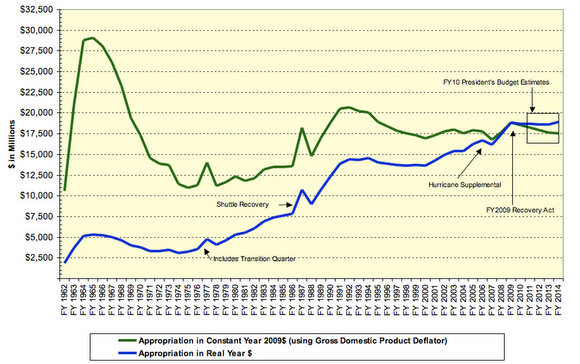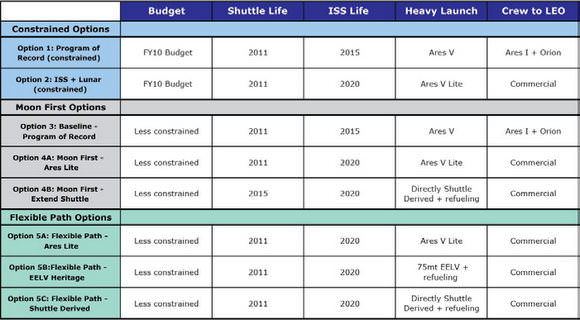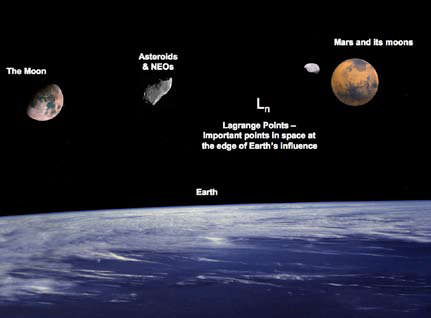[/caption]
The Augustine Commission released their final report today, and while they didn’t offer specific recommendations for NASA’s human space flight program, they laid out five possible options, highlighting a flexible plan that allows for several destinations out of low Earth orbit. The report also encouraged commercial space ventures to handle trips to the International Space Station. “The different options speak for themselves,” said head of the commission, Norman Augustine at a press briefing today following the release of the report. “We believe Mars is clear goal of the human spaceflight program, but for safety reason we ruled out going directly there. We’ve offered programs that are alternatives for building a heavy lift launch capability, as we believe that to be extremely important for the human space program, and we believe this is the time to create a commercial market to transport humans to Earth orbit.”
But the strongest point the committee made is that NASA needs additional funds of $3 billion a year in order to accomplish much of anything.
“The premier conclusion of the committee is that the human spaceflight program is on a unsustainable trajectory,” Augustine said. “We say that because of a mismatch of the scope of the program and the funds available.”
In the report, the committee said either additional funds need to be made available or a far more modest program involving little or no exploration needs to be adopted.

Meanwhile, the White House said today that President Obama is committed to human space explorations and wants the US to have a vigorous & sustainable program, but offered no specifics on how the administration might proceed following the release of the report. NASA administrator Charlie Bolden said he would be meeting with the president in November.
The 157-page report titled “Seeking a Human Spaceflight Program Worthy of a Great Nation,” does not differ from a preliminary report issued in August, but offers “substantiation” for their views, Augustine said.
The consensus of the committee was that NASA should conduct a human space flight program somewhat different than the current path of returning to the Moon. The “flexible” plan would allow for reaching exciting and different destinations sooner than landing on the Moon.
“There are a lot of things we could do along the way to build up to a Mars program,” Augustine said, “such as a circumlunar program, circle Mars, land on an asteroid, land on Phobos or Deimos and do some exciting science from there. We could do those things rather than wait 15 years for the first major event.”
Another committee member Ed Crawley added, “What causes flexible path to make sense is that you can build some of the overall system, the booster and capsule and then you can start going places, like flying around the moon, then to a near Earth object. And it would be less energetically intensive to do a flyby of Mars than to land on the surface of the Moon. You could build the heavy booster and a capsule, and start exploring, and then later build the landers.”
Crawley compared the options to saving longer to buy a big camper or saving for a short period of time to buy a station wagon and then later purchasing a camper to hook onto the car.
When asked for a timetable, Crawley and Augustine said it was likely NASA could leave LEO in the early 2020’s. “Early- to mid- 2020’s without pinning down an exact year, which would be several years earlier than we would get to the moon,” Crawley said.
The report suggested extending the space shuttle program until 2011, instead of the current goal of retiring the program in 2010. “The flight rate to 2010 is roughly double that of what has been demonstrated since the loss of Columbia,” Augustine said. “We believe it would be prudent to put funds in 2011 to fly a better, realistic schedule. NASA has no money in the current budge to do that, we believe it should.”
As for the Ares program, the panel did not call it an engineering failure but rather a victim of smaller-than-expected budgets and changing circumstances. “With time and sufficient funds, NASA could develop, build and fly the Ares I successfully,” the report said. “The question is, should it?”
They said the Ares I-X test flight next week should go ahead as scheduled, because there still would be much to learn from the demonstration. But because of the slipping dates of when the spacecraft would be ready, it would likely be too late for one of its primary tasks, ferrying astronauts to and from the space station. The panel said a better option for low-Earth orbit transport would be private commercial space companies. Augustine said NASA should focus on going beyond low Earth orbit rather than having a trucking service to LEO.
The panel also discussed heavy-lift rocket based on rockets currently used by the Air Force to lift satellites or one based more closely on the space shuttle design. (See our previous article on that subject.)
The committee also urged extending the life of the ISS to 2020. “The Committee finds that the return on investment from the ISS to both the United States and the international partners would be significantly enhanced by an extension of its life to 2020. It seems unwise to de-orbit the Station after 25 years of planning and assembly and only five years of operational life. A decision not to extend its operation would significantly impair the U.S. ability to develop and lead future international spaceflight partnerships. Further, the return on investment from the ISS would be significantly increased if it were funded at a level allowing it to achieve its full potential.”
In a nutshell, here are the 5 alternatives the committee came up with
1. Maintain all programs as is, but extend the space shuttle program to 2011 and ISS to 2020. Without extra funding, the Ares rockets wouldn’t be ready until 2020 and there would never be enough money to go to the Moon.
2. Maintain current funding, scrap Ares I, develop an Ares V lite version (about 2/3 of Ares V heavy) and divert extra funds to ISS for extension to 2020. Buy commercial LEO human space flight. The Ares might be ready by 2025, and perhaps get to the Moon after 2030.
3. Add $3 billion per year and proceed with the Constellation program to return to the Moon. The ISS would have to be de-orbited in 2016 to allow a return to the Moon by about 2025.
4. Add $3 billion per year. Extend the ISS to 2020 and get to the Moon by about 2025. Use either Ares V Lite, or Shuttle-C for heavy lift.
5. Add $3 billion per year. Extend the shuttle program to 2011 and extend ISS to 2020. Instead of heading to land on the Moon, orbit the Moon, or go to Near Earth Objects and prepare to go to Mars. Use either Ares V Lite; a heavy Evolved Expendable Launch Vehicles (EELV) or, a shuttle-derivative.

Watch Norman Augustine’s opening remarks from the press conference today:
Sources: Augustine Report, press briefing

